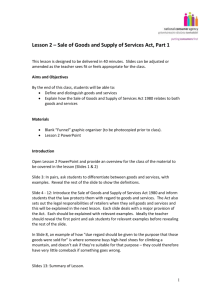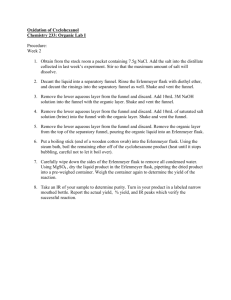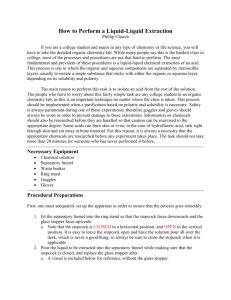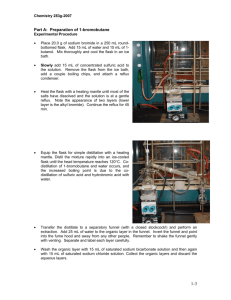Synthesis of tert-BuCl
advertisement
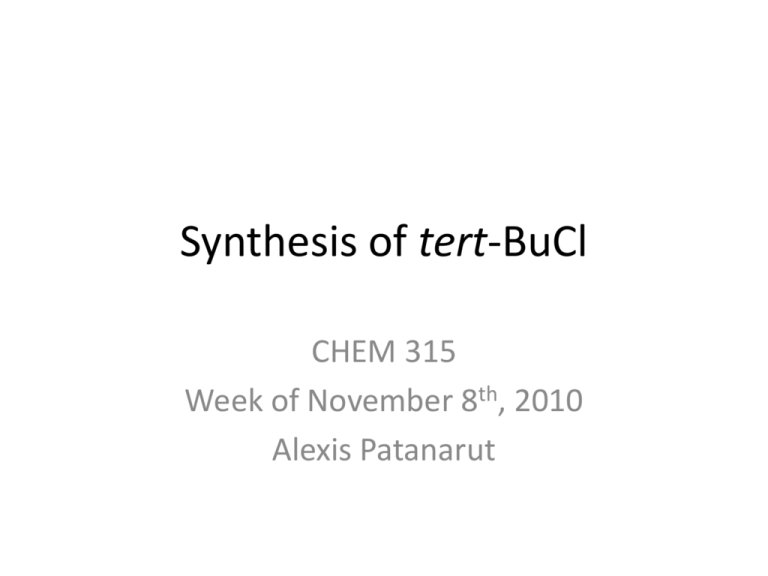
Synthesis of tert-BuCl CHEM 315 Week of November 8th, 2010 Alexis Patanarut Due dates Today • GC of Distillate lab report - at the beginning of class • Carbon copies from your lab notebook - at the end of class Two weeks (after Thanksgiving break) • Synthesis of t-BuCl lab report – Includes synthesis scheme of t-BuCl – See http://classweb.gmu.edu/chemlab/sws/flow2.gif for example) Purpose • To synthesize t-BuCl and learn how to do liquid-liquid extraction using a separatory funnel Procedure – initial reaction • Obtain t-Butyl alcohol (11 mL) from instructor. Weigh vial and its contents, then pour the alcohol into a 125 mL separatory funnel. Weigh the empty vial and take the difference to find the weight of the alcohol – – • Make sure the stopcock is closed before pouring anything in! If the alcohol has solidified, you can liquify it again by warming it between your hands Add 25 mL concentrated HCl to the alcohol on the separatory funnel and gently swirl the mixture for ~1 minute, unstoppered Procedure – initial reaction • Put the stopper on the funnel and press down firmly, then gently invert funnel without shaking and carefully open the stopcock to vent • Close the stopcock again and shake the funnel several times, then release pressure through the stopcock – Repeat this shake/vent step for 2 - 3 minutes, then allow the mixture to separate into two layers. • Separate the two layers. – Which layer is on top based on density? Extraction procedure • Must be done quickly, since t-BuCl is unstable in water and sodium carbonate – Use 10 mL portions of extraction solvents – Organic layer will be extracted (swirl and shake) once with water, two (2) times with sodium carbonate and once again with water • Swirl the contents gently in unstoppered funnel. Then put on stopper and carefully invert it, opening to stopcock to vent • Gently shake the funnel with frequent venting for ~1 minute, then allow layers to separate • Drain the lower aqueous/bicarbonate layer into waste beaker and keep top organic layer in funnel Drying procedure • Drain organic layer into a small (50 mL) clean, dry beaker and add anhydrous sodium sulfate to the crude product, swirling until clear – Add drying agent using tip-fulls of large microspatula (0.5 g to 1.0 g), one portion at a time • Swirl the mixture during drying period – Watch for clumping of drying agent; if drying agent clumps, add a bit more – You want to add drying agent until you see some of it not clumping, at which you stop adding the drying agent; avoid adding too much drying agent, as that could reduce product recovery • When the solution is clear (dry), carefully decant the produce into a distilling flask using a funnel to prevent contamination of the flask neck Distillation procedure • Add 1-3 boiling chips into distilling flask and distill crude product using simple distillation set-up • Collect distilled product into receiving vessel over ice – Might want to preweigh receiving vessel for later mass calculation purposes – Product will distill 3-4 deg C before and after literature b.p. of t-BuCl For next lab period 1. Weigh the product and determine product (%) yield 2. Find refractive index 3. Get IR spectrum Final notes • • • • Store your t-BuCl in a tightly capped vial since it can evaporate very easily Dispose aqueous solutions in the sink with plenty of water Pour distillation waste into waste jar in the hood Take good notes in your lab notebook! – Last two labs are more or less cumulative in the techniques you’ve learned this semester, so be sure to take good and thorough notes in your notebook – I will be checking your carbon copies for this!

